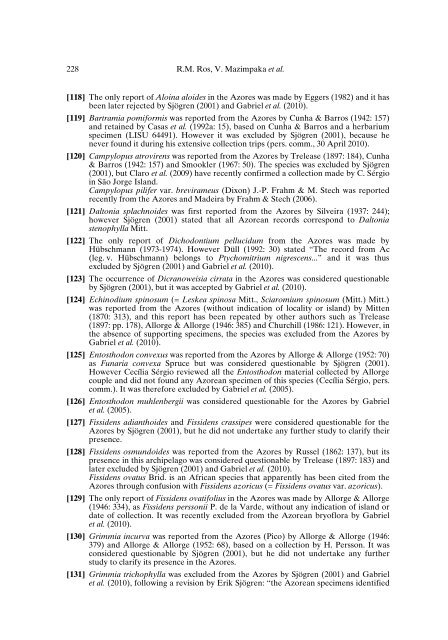Mosses of the Mediterranean, an annotated checklist - Optima-bot.org
Mosses of the Mediterranean, an annotated checklist - Optima-bot.org
Mosses of the Mediterranean, an annotated checklist - Optima-bot.org
You also want an ePaper? Increase the reach of your titles
YUMPU automatically turns print PDFs into web optimized ePapers that Google loves.
228 R.M. Ros, V. Mazimpaka et al.[118] The only report <strong>of</strong> Aloina aloides in <strong>the</strong> Azores was made by Eggers (1982) <strong>an</strong>d it hasbeen later rejected by Sjögren (2001) <strong>an</strong>d Gabriel et al. (2010).[119] Bartramia pomiformis was reported from <strong>the</strong> Azores by Cunha & Barros (1942: 157)<strong>an</strong>d retained by Casas et al. (1992a: 15), based on Cunha & Barros <strong>an</strong>d a herbariumspecimen (LISU 64491). However it was excluded by Sjögren (2001), because henever found it during his extensive collection trips (pers. comm., 30 April 2010).[120] Campylopus atrovirens was reported from <strong>the</strong> Azores by Trelease (1897: 184), Cunha& Barros (1942: 157) <strong>an</strong>d Smookler (1967: 50). The species was excluded by Sjögren(2001), but Claro et al. (2009) have recently confirmed a collection made by C. Sérgioin São J<strong>org</strong>e Isl<strong>an</strong>d.Campylopus pilifer var. brevirameus (Dixon) J.-P. Frahm & M. Stech was reportedrecently from <strong>the</strong> Azores <strong>an</strong>d Madeira by Frahm & Stech (2006).[121] Daltonia splachnoides was first reported from <strong>the</strong> Azores by Silveira (1937: 244);however Sjögren (2001) stated that all Azore<strong>an</strong> records correspond to Daltoniastenophylla Mitt.[122] The only report <strong>of</strong> Dichodontium pellucidum from <strong>the</strong> Azores was made byHübschm<strong>an</strong>n (1973-1974). However Düll (1992: 30) stated “The record from Ac(leg. v. Hübschm<strong>an</strong>n) belongs to Ptychomitrium nigrescens...” <strong>an</strong>d it was thusexcluded by Sjögren (2001) <strong>an</strong>d Gabriel et al. (2010).[123] The occurrence <strong>of</strong> Dicr<strong>an</strong>oweisia cirrata in <strong>the</strong> Azores was considered questionableby Sjögren (2001), but it was accepted by Gabriel et al. (2010).[124] Echinodium spinosum (= Leskea spinosa Mitt., Sciaromium spinosum (Mitt.) Mitt.)was reported from <strong>the</strong> Azores (without indication <strong>of</strong> locality or isl<strong>an</strong>d) by Mitten(1870: 313), <strong>an</strong>d this report has been repeated by o<strong>the</strong>r authors such as Trelease(1897: pp. 178), All<strong>org</strong>e & All<strong>org</strong>e (1946: 385) <strong>an</strong>d Churchill (1986: 121). However, in<strong>the</strong> absence <strong>of</strong> supporting specimens, <strong>the</strong> species was excluded from <strong>the</strong> Azores byGabriel et al. (2010).[125] Entosthodon convexus was reported from <strong>the</strong> Azores by All<strong>org</strong>e & All<strong>org</strong>e (1952: 70)as Funaria convexa Spruce but was considered questionable by Sjögren (2001).However Cecília Sérgio reviewed all <strong>the</strong> Entosthodon material collected by All<strong>org</strong>ecouple <strong>an</strong>d did not found <strong>an</strong>y Azore<strong>an</strong> specimen <strong>of</strong> this species (Cecília Sérgio, pers.comm.). It was <strong>the</strong>refore excluded by Gabriel et al. (2005).[126] Entosthodon muhlenbergii was considered questionable for <strong>the</strong> Azores by Gabrielet al. (2005).[127] Fissidens adi<strong>an</strong>thoides <strong>an</strong>d Fissidens crassipes were considered questionable for <strong>the</strong>Azores by Sjögren (2001), but he did not undertake <strong>an</strong>y fur<strong>the</strong>r study to clarify <strong>the</strong>irpresence.[128] Fissidens osmundoides was reported from <strong>the</strong> Azores by Russel (1862: 137), but itspresence in this archipelago was considered questionable by Trelease (1897: 183) <strong>an</strong>dlater excluded by Sjögren (2001) <strong>an</strong>d Gabriel et al. (2010).Fissidens ovatus Brid. is <strong>an</strong> Afric<strong>an</strong> species that apparently has been cited from <strong>the</strong>Azores through confusion with Fissidens azoricus (= Fissidens ovatus var. azoricus).[129] The only report <strong>of</strong> Fissidens ovatifolius in <strong>the</strong> Azores was made by All<strong>org</strong>e & All<strong>org</strong>e(1946: 334), as Fissidens perssonii P. de la Varde, without <strong>an</strong>y indication <strong>of</strong> isl<strong>an</strong>d ordate <strong>of</strong> collection. It was recently excluded from <strong>the</strong> Azore<strong>an</strong> bry<strong>of</strong>lora by Gabrielet al. (2010).[130] Grimmia incurva was reported from <strong>the</strong> Azores (Pico) by All<strong>org</strong>e & All<strong>org</strong>e (1946:379) <strong>an</strong>d All<strong>org</strong>e & All<strong>org</strong>e (1952: 68), based on a collection by H. Persson. It wasconsidered questionable by Sjögren (2001), but he did not undertake <strong>an</strong>y fur<strong>the</strong>rstudy to clarify its presence in <strong>the</strong> Azores.[131] Grimmia trichophylla was excluded from <strong>the</strong> Azores by Sjögren (2001) <strong>an</strong>d Gabrielet al. (2010), following a revision by Erik Sjögren: “<strong>the</strong> Azore<strong>an</strong> specimens identified






